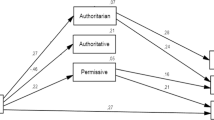Abstract
We investigated behavioural and cognitive representations of attachment style. Specifically, we sought to test continuity in attachment style and whether participants' perceptions of their attachments to parents, peers, and romantic partners would predict cognitive interpretation and responses to 12 ambiguous situation scenarios. Participants were 161 undergraduate students (17–20 years) who completed the Parental Bonding Instrument, the Attachment Style Questionnaire and the Inventory of Parent and Peer Attachment (peer subscale). Participants then indicated whether they interpreted ambiguous situations as threatening versus non-threatening and how they would respond (proactively, aggressively, or avoidantly). Regression analyses revealed that insecure parental attachments were the main predictor of participants' interpretations and their planned responses, followed by romantic attachments. Peer attachments played little role in the predictions. These results suggest that interpretation of situations and subsequent plans of action may be influenced by attachment related experiences. We discuss our findings in terms of their relevance to attachment theory and their application to our understanding of the concepts of attachment in development of interpersonal relationships.
Similar content being viewed by others
REFERENCES
Armsden, G. C., & Greenberg, M. T. (1987). The inventory of parent and peer attachment: Individual differences and their relationship to psychological well-being in adolescence. Journal of Youth and Adolescence, 16 427-454.
Barrett, P. M., Rapee, R. M., Dadds, M. R., & Ryan, S. M. (1996). Family enhancement of cognitive style in anxious and aggressive children. Journal of Abnormal Child Psychology, 24 187-203.
Blain, M. D., Thompson, J. M., & Whiffen, V. E. (1993). Attachment and perceived social support in late adolescence: The interaction between working models of self and others. Journal of Adolescent Research, 8 226-241.
Bowlby, J. (1973). Attachment and loss: Volume 2. New York: Basic Books.
Bowlby, J. (1981). Attachment and loss: Volume 3. Victoria: Penguin Books.
Bretherton, I. (1985). Attachment theory: Retrospect and prospect. In I. Bretherton & E. Waters (Eds.), Growing points in attachment theory and research. Monograph for the society for research in child development (pp.3-35). Chicago: University of Chicago Press.
Collins, N. L., & Read, S. J. (1990). Adult attachment, working models, and relationship quality in dating couples. Journal of Personality and Social Psychology, 58 644-693.
Feeney, J., & Noller, P. (1990). Attachment style as a predictor of adult romantic relationships. Journal of Personality and Social Psychology, 58 281-291.
Feeney, J. A., Noller, P., & Hanraharn, M. (1994). Assessing Adult Attachment. In M. B. Sperling & W. H. Berman (Eds.), Attachment in adults: Clinical and developmental perspectives (pp. 128-152). New York: Guilford Press.
Gold, M., & Yanof, D. S. (1985). Mothers, daughters, and girlfriends. Journal of Personality and Social Psychology, 49 654-659.
Greenberg, M. T., Siegel, J. M., & Leitch, C. J. (1983). The nature and importance of attachment relationships to parents and peers during adolescence. Journal of Youth and Adolescence, 12 373-386.
Hazan, C., & Shaver, P. (1987). Romantic love conceptualised as an attachment process. Journal of Personality and Social Psychology, 52 511-524.
Kobak, R. R., & Sceery, A. (1988). Attachment in late adolescence:Working models, affect regulation, and representations of self and others. Child Development, 59 135-146.
Lyddon, W. J., Bradford, E., & Nelson, J. P. (1993). Assessing adolescent and adult attachment: A review of current self-report measures. Journal of Counselling and Development, 71 390-395.
Mackinnon, A. J., Henderson. A. S., & Andrews, G. (1993). Parental affectionless control as an antecedent to adult depression: A risk factor refined. Psychological Medicine, 23 24-27.
McCormick, C. B. & Kennedy, J. H. (1994). Parent-child attachment working models and self-esteem in adolescence. Journal of Youth and Adolescence, 23 1-18.
Papini, D. R., & Roggman, L. A. (1992). Adolescence perceived attachment to parents in relation to competence, depression, and anxiety: A longitudinal study. Journal of Early Adolescence, 12 420-440.
Parker, G. (1979). Parental characteristics in relation to depressive disorders. British Journal of Psychiatry, 134 138-147.
Parker, G. (1990). The parental bonding instrument: A decade of research. Social Psychiatry and Psychiatric Epidemiology, 25 281-282.
Parker, G., Tupling, H., & Brown, L. B. (1979). A parental bonding instrument. British Journal of Medical Psychology, 52 1-10.
Pedersen, W. (1994). Parental relations, mental health, and delinquency in adolescence. Adolescence, 29 975-990.
Rey, J. M. (1995). Perceptions of poor maternal care are associated with adolescent depression. Journal of Affective Disorders, 34 95-100.
Schneider, E. L. (1991). Attachment theory and research: Review of the literature. Clinical Social Work Journal, 19 251-266.
Sroufe, L. A., & Fleeson, J. (1986). Attachment and the construction of relationships. In W. Hartup & Z. Rubin (Eds.). Relationships and development (pp. 51-71). Hillsdale, NJ: Erlbaurn.
Weiss, R S. (1982). Attachment in adult life. In C. M. Parkes and J. S. Stevenson-Hinde (Eds.), The place of attachment in human behaviour (pp. 268-294). New York: Basic Books.
Wilhelm, K., & Parker, G. (1990). Reliability of the parental bonding instrument and intimate bonds measure scales. Australian and New Zealand Journal of Psychiatry, 24 199-202.
Author information
Authors and Affiliations
Rights and permissions
About this article
Cite this article
Barrett, P.M., Holmes, J. Attachment Relationships as Predictors of Cognitive Interpretation and Response Bias in Late Adolescence. Journal of Child and Family Studies 10, 51–64 (2001). https://doi.org/10.1023/A:1016677416638
Issue Date:
DOI: https://doi.org/10.1023/A:1016677416638




